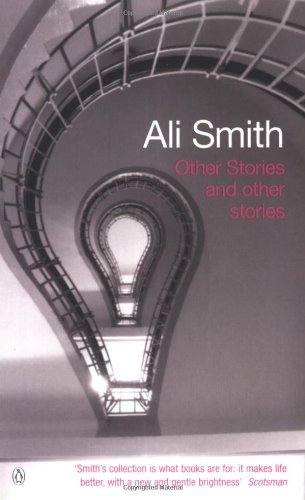
photo by Toshiyuki IMAI
by Tracy Maylath
Consider the word ‘quirky’. Consider the number of times the word is applied to the works of Ali Smith. Consider the injustice and misplacement of it. Her stories deserve better than a synonym of the warily patronising ‘kooky’.
Smith’s writing is, indeed, away from the ‘norm’ and possessing peculiarities – especially in ‘May’, ‘Scottish Love Songs’ and ‘The Hanging Girl’. It’s easy to become distracted by the way her considerations – of how to structure the story, where to start it – make it onto the page. Like an algebra exam where it instructs, ‘please show how you arrived at your answer’.
We might feel bereft of the traditional build of a sentence, using a subject, verb and object fixed together with the dab of a clause or two. We could be preoccupied by Smith’s seemingly insouciant attitude toward traditional punctuation, her use of a – and the lack of some “_“.
We are sure to uncover more evidence of her ‘quirkiness’ in her transparent word play, so evident in ‘The Hanging Girl’, during dialogue with an echo:
Bless me.
Less me, the echo said…
Nothing there, she said.
Air, the echo said.
And then there’s the to and fro-ing with point of view. Who are these characters? Are they mad? They fall in love with trees, they’re followed through a tube station by a spectral ‘pipe band in full regalia’, they’re haunted by a girl executed by hanging.
But maybe it’s not that these stories are ‘quirky’, it’s that so many others are too sedate.
 Here’s a tip: discover Ali Smith’s collections The Whole Story and Other Stories and Other Stories and Other Stories. Read every story. In any order. Don’t read them for plot. (Yes, readers like plot. Yes, publishers like plot – because plot sells and gets made into films.) Read them for story instead.
Here’s a tip: discover Ali Smith’s collections The Whole Story and Other Stories and Other Stories and Other Stories. Read every story. In any order. Don’t read them for plot. (Yes, readers like plot. Yes, publishers like plot – because plot sells and gets made into films.) Read them for story instead.
The story is there. And the characters are there. All the features of tradition are there. Just with a looser structure. Smith trusts her readers to figure it out.
I start with ‘May’ because, in terms of story, it’s the most traditional. ‘I tell you. I fell in love with a tree. I couldn’t not. It was in blossom.’ The plot is: there was a tree that blossomed, and a woman falls in love with it. The story is about owning property – the woman on whose land the tree grows calls the police when our protagonist lingers in her garden too long, mooning over the tree. But the reader has to look for a fleeting clue to see what it’s truly about. That clue is the graffiti stating ‘Property is Theft’. It’s about petty bureaucracy. And later the protagonist wonders if the Council might have someone whose job it is to inspect the ground for places where people might trip: ‘Inspector of Pavements and Roads. Kerb Auditor. Local Walkways Erosion Consultant.’ Or they might call themselves ‘an Asphalt Observance Manager’.
The story is also about love for another, despite their oddities, despite the object of one’s affections not being human. But it’s not spelled out. It’s hidden in hints of the myths of Baucis and Philemon, who ask the Gods to turn them into trees so they can live entwined with each other for eternity.
I remember the story about the old couple who are turned into two trees; they let the strangers who knock at the door into their house then find that the gods have visited, and their favour is granted to them.
The myths of Cyparissus are hinted at too, whose grief over his dead stag is so great that he is transformed into a cypress, the symbol of mourning. And of Daphne, who metamorphoses into a tree to escape Apollo. Smith only intimates these myths, though: ‘I search around in the books […] I find the one about the grieving youth who becomes a tree.’ And once these clues are joined together we see that the protagonist is not just some oddball who has fallen in love with a tree.
It’s not that there isn’t a plot. It just needs to be pieced together.
Of course, ‘Scottish Love Songs’ is also about love. It’s in the title. But whose love? Is it Chelsea’s love for her best friend? Or Violet’s for a long lost lover? Could it even be the Scottish bagpipe band’s unending love for their music, their country? No need to worry about spoilers with Smith’s stories. They’re more subjective because they depend on which clues the reader focuses.
 Take the glass and the crystal as an example. Violet’s mercenary daughter taps a crystal to hear if it pings. This might be a clue about the naivety of privilege and youth. The elderly lady, made deaf by the banging din of the ghostly bagpipes played at full volume in her attic, ‘tapped her foot to count herself in and she sang a song to the visiting rich girl’ after enlightening her about the wonders of Niagara Falls. She shouts to the girl, Chelsea: ‘Smooth on the top like simmering and then it all falls away. It’ll be the same to this day.’ There’s the clue: an element of nature that will still be the same as it was fifty years ago. Because the story here is also about climate change, and perhaps the rich girl isn’t quite so naïve after all:
Take the glass and the crystal as an example. Violet’s mercenary daughter taps a crystal to hear if it pings. This might be a clue about the naivety of privilege and youth. The elderly lady, made deaf by the banging din of the ghostly bagpipes played at full volume in her attic, ‘tapped her foot to count herself in and she sang a song to the visiting rich girl’ after enlightening her about the wonders of Niagara Falls. She shouts to the girl, Chelsea: ‘Smooth on the top like simmering and then it all falls away. It’ll be the same to this day.’ There’s the clue: an element of nature that will still be the same as it was fifty years ago. Because the story here is also about climate change, and perhaps the rich girl isn’t quite so naïve after all:
She thought about the contents of nitrogen and oxygen in air […] She thought how it was spring on the other side of the world, winter was finished over there and just about to start here in this unnatural warm. She thought about what would happen if global warming continued destabilising the climate.
This clue may seem obvious when separated out as it is above. But, in the story, it is woven through the reminiscence of Chelsea’s dream about her best friend, Amanda. And then the bagpipe band queue behind her in the deli and are impossible to ignore, being as they are ‘burly men’ who ‘scraped the tall stems of their bagpipes against the ceiling and knocked their bearskins squint on the doorframes and pelmets.’
In the way that apparitional bagpipe players, who ‘bray their noise’ at you, are impossible to overlook, so is a girl, hanging from a lamppost outside a shop, her head ‘swung down loose’.
The clues in ‘The Hnaging Girl’ are harder. Even when people ask on forums, ‘who is the hanging girl? What was her crime?’, there is nothing. So here is my best guess answer to the question thrown open by this story…
She could well be based on Masha Bruskina, a seventeen-year-old volunteer nurse and member of the Minsk Resistance movement during WWII. She and two others were hanged by the German authorities in 1941. Like the hanging girl in the story, she is told she is being made an example of, she wears a placard in two languages (Russian and German) proclaiming that she is a partisan. Pauline, who is being haunted by the hanging girl says, “I don’t believe she understands English, even if she could talk”. It’s a hint, I think.
There are photographs of the real hanging. In the story, the hangings are being filmed. Until 2009, the plaque commemorating Masha simply stated she was ‘the unknown girl’. We know the girl in the story only as ‘the hanging girl’. Masha was executed in October. For the hanging girl, it is spring. As we read her inner thoughts we note her glee at this fact. There is no solemnity now she is to be made a ghost. She makes a performance of her execution, laced with puns and cheap jokes:
…a very warm welcome to the show I’m your (g)host for this evening […] we’re going to have a really great time together […] why couldn’t they hang the insolent girl? because she had such a – yes – brass neck (laughter and clapping).
After she’s been hung she notes, ‘my head at its broken angle. My eyes gone. The creak of the rope on the beam above’.
 And then we’re with Pauline, who is visiting the doctor because she is being followed by the hanging girl. “Actually it’s getting to be a bit of a pain in the neck,” she tells the doctor. The doctor prescribes antibiotics and refers her to a counsellor. But Pauline cancels her appointments minutes after they are made. The hanging girl, who is ‘always sore’, will alleviate Pauline’s anguish.
And then we’re with Pauline, who is visiting the doctor because she is being followed by the hanging girl. “Actually it’s getting to be a bit of a pain in the neck,” she tells the doctor. The doctor prescribes antibiotics and refers her to a counsellor. But Pauline cancels her appointments minutes after they are made. The hanging girl, who is ‘always sore’, will alleviate Pauline’s anguish.
The hanging girl, in death, retains her sense of humour even in the constant proof of her torment. Her head, in death, lists at a broken angle. But she hangs herself from whatever is available, from a lamppost to Pauline’s kitchen clock, pretending she is a pendulum. She hangs on the wall like a picture evoking the Jewish children of the Bullenhuser Damm, who were executed by hanging from the picture hooks on the school walls so no one would know.
These clues need to be pieced together. Or maybe they don’t. Maybe we just need to read for where the story aches. For me, it’s about the survivor’s guilt, as Pauline thinks:
…it’s the same for everyone; every one of us falling through the air with one end of the rope attached to our birthdates till the rope pulls tight […] But she looks at me with her white eyes […] and I know what the look means. Some people are pushed. Some people aren’t given enough rope. You can’t know what it was like.
It’s also about the officials, looking on at the suffering, who did nothing. Pauline breaks her leg:
I can’t help you, love, he told Pauline. I’m the reporting officer. Even if you were on fire, even if you were bleeding to death right here in front of me on the lawn, I’d not be able to do anything. It’s my duty only to report what happens…
And it’s about living in the aftermath of tragedy: ‘Christ but something’s really aching somewhere. God, though, what a beautiful day.’
Or that’s all wrong. And that’s the point. Read again.
Something’s really aching in these. God, though, what beautiful stories.

